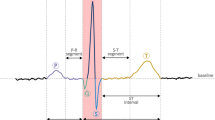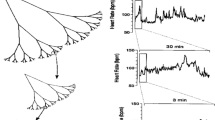Abstract
Any significant alteration in the Electro-Cardio-Gram (ECG) signal wave components (P-QRS-T) for a time duration is detected as arrhythmia. In this paper, a novel fractional wavelet transform (FrWT) is used as a preprocessing tool. FrWT describes the given signal in time–frequency fractional domain using fractional Fourier transform and its denoising using wavelet transform. Because of this novel and intriguing property, it is broadly utilized as a noise removal tool in the fractional domain along with multiresolution analysis. Next, features are extracted using Yule–Walker autoregressive modeling. Dimensionality of the extracted features is to be reduced for proper detection of different types of arrhythmias. Principal component analysis has been applied for arrhythmia detection using variance estimation. The proposed method is evaluated on the basis of various performance parameters such as output SNR, mean squared error (MSE) and detection accuracy (\( {\text{DE}}_{\text{Acc}} \)). An output SNR of 33.41 dB, MSE of 0.1689% and Acc of 99.94% for real-time ECG database and output SNR of 25.25 dB, MSE of 0.1656%, \( {\text{DE}}_{\text{Acc}} \) of 99.89% for MIT-BIH Arrhythmia database are obtained.





Similar content being viewed by others
References
S.O. Rajankar, S.N. Talbar, An electrocardiogram signal compression techniques: a comprehensive review. Analog Integr. Circuits Signal Process. 98, 59–74 (2018)
S. Sahoo, P. Biswal, T. Das, S. Sabut, De-noising of ECG signal and QRS detection using Hilbert transform and adaptive thresholding. Procedia Technol. 25, 68–75 (2016)
R.J. Martis, U.R. Acharya, K.M. Mandana, A.K. Ray, C. Chakraborty, Application of principal component analysis to ECG signals for automated diagnosis of cardiac health. J. Expert Syst. Appl. 39, 11792–11800 (2012)
P.S. Addison, Wavelet transforms and the ECG: a review. Physiol. Meas. 26, 155–199 (2005)
M.V. Kamath, T. Bentley, R. Spaziani, G. Tougas, E.L. Fallen, N. McCartney, J. Runions, A.R.M. Upton, Time–frequency analysis of heart rate variability signals in patients with autonomic dysfunction, in International Symposium on Time–Frequency and Time-Scale Analysis (TFTS-1996) (1996), pp. 373–376
S. Qin, Z. Ji, Multi-resolution time-frequency analysis for detection of rhythms of EEG signals, in 2004 IEEE 11th Digital Signal Processing Workshop & IEEE Signal Processing Education Workshop (IEEE DSP 2004) (2004), pp. 338–341
A.J.M.D. Meireles, ECG denoising based on adaptive signal processing technique. Thesis, Master of Technology in Electronics and Computer Science, Instituto Superior de Engenharia do Porto Portugal, 2011
M. Das, S. Ari, Analysis of ECG signal denoising method based on S-transform. IRBM 34(6), 362–370 (2013)
E.J.S. Luz, W.R. Schwartz, G.C. Chávez, D. Menotti, ECG-based heartbeat classification for arrhythmia detection: a survey. Comput. Methods Prog. Biomed. 127, 144–164 (2016)
V. Gupta, M. Mittal, R-peak detection in ECG signal using Yule-Walker and principal component analysis. IETE J. Res. (2019). https://doi.org/10.1080/03772063.2019.1575292
V. Gupta, M. Mittal, Electrocardiogram signals interpretation using Chaos theory. J. Adv. Res. Dyn. Control Syst. 10(2), 2392–2397 (2018)
V. Gupta, M. Mittal, A novel method of cardiac arrhythmia detection in electrocardiogram signal. Int. J. Med. Eng. Inform. 12(5), 489-499 (2020). https://www.inderscience.com/info/ingeneral/forthcoming.php?jcode=ijmei
I. Kaur, R. Rajni, A. Marwaha, ECG signal analysis and arrhythmia detection using wavelet transform. J. Inst. Eng. India Ser. B 97(4), 499–507 (2016)
H.M. Rai, A. Trivedi, K. Chatterjee, S. Shukla, R-peak detection using Daubechies wavelet and ECG signal classification using radial basis function neural network. J. Inst. Eng. India Ser. B 95(1), 63–71 (2014)
G. Bhatnagar, Q.M.J. Wua, B. Raman, Discrete fractional wavelet transform and its application to multiple encryption. Inf. Sci. 223, 297–316 (2013)
A. Ouelli, B. Elhadadi, H. Aissaoui, B. Bouikhalene, AR modeling for cardiac arrhythmia classification using MLP neural networks. Int. J. Comput. Appl. 47(24), 44–51 (2012)
M. Arnold, W.H.R. Miltner, H. Witte, R. Bauer, C. Braun, Adaptive AR modeling of nonstationary time series by means of Kalman filtering. IEEE Trans. Biomed. Eng. 45(5), 553–562 (1998)
M.P.S. Chawla, Segment classification of ECG data and construction of scatter plots using principal component analysis. J. Mech. Med. Biol. 8(3), 421–458 (2008)
Physionet database/MITBIH Arrhythmia database. Accessed 22 Nov 2017
H. Dai, Z. Zheng, W. Wang, A new fractional wavelet transform. Commun. Nonlinear Sci. Numer. Simul. 44, 19–36 (2017)
C. Guo, The application of fractional wavelet transform in image enhancement. Int. J. Comput. Appl. (2019). https://doi.org/10.1080/1206212X.2019.1626573
J. Shi, N. Zhang, X. Liu, A novel fractional wavelet transform and its applications. Sci. China Inf. Sci. 55(6), 1270–1279 (2011)
M. Alfaouri, K. Daqrouq, ECG signal denoising by wavelet transform thresholding. Am. J. Appl. Sci. 5(3), 276–281 (2008)
V. Gupta, M. Mittal, A Comparison of ECG signal pre-processing using FrFT, FrWT and IPCA for improved analysis. Innov. Res. Biomed. Eng. IRBM (2019). https://doi.org/10.1016/j.irbm.2019.04.003
A. Dliou, R. Latif, M. Laaboubi, F.M.R. Maoulainine, Abnormal ECG signal analysis using non parametric time-frequency techniques. Arabian J. Sci. Eng. 39(2), 913–921 (2014)
R.J. Martis, U.R. Acharya, C.M. Lim, J.S. Suri, Characterization of ECG beats from cardiac arrhythmia using discrete cosine. Knowl. Based Syst. 45, 76–82 (2013)
M.R. Homaeinezhad, S.A. Atyabi, E. Tavakolli, H.N. Toosi, A. Ghaffari, R. Ebrahimpour, ECG arrhythmia recognition via a neuro-SVM–KNN hybrid classifier with virtual QRS image-based geometrical features. Expert Syst. Appl. 39(2), 2047–2058 (2012)
V. Gupta, M. Mittal, Respiratory signal analysis using PCA, FFT and ARTFA, in 2016 IEEE Proc. of ICEPES-16. Maulana Azad National Institute of Technology, Bhopal (2016), pp. 221–225
C.H. Lin, Frequency-domain features for ECG beat discrimination using grey relational analysis-based classifier. Comput. Math. Appl. 55(4), 680–690 (2008)
E.D. Übeyli, Statistics over features of ECG signals. Expert Syst. Appl. 36(5), 8758–8767 (2009)
I. Güler, E.D. Übeyli, ECG beat classifier designed by combined neural network model. Pattern Recognit. 38(2), 199–208 (2005)
S.M. Kay, Modern Spectral Estimation: Theory and Application, Signal Processing Series, 1988, 1st edn. (Prentice Hall, Englewood Cliffs, 1998), pp. 328–457
M. Kallas, P. Honeine, C. Richard, C. Francis, H. Amoud, Prediction of time series using Yule–Walker equations with kernels, in 2012 IEEE Int conf. on Acoustics, Speech and Signal Processing (ICASSP 2012) (2012), pp. 2185–2188
A. Tomar, Various classifiers based on their accuracy for age estimation through facial features. Int. Res. J. Eng. Technol. 3(7), 1679–1682 (2016)
M.P.S. Chawla, A comparative analysis of principal component and independent component techniques for electrocardiograms. J. Neural Comput. Appl. 18(6), 539–556 (2009)
S. Nikan, F.G. Sridhar, M. Bauer, Pattern recognition application in ECG arrhythmia classification, in 10th Int Joint Conference on Biomedical Engineering Systems and Technologies (BIOSTEC 2017) (2017), pp. 48–56
Y.C. Yeh, W.J. Wang, C.W. Chiou, Cardiac arrhythmia diagnosis method using linear discriminant analysis on ECG signals. Measurement 42(5), 778–789 (2009)
D. Singh, B.S. Saini, V. Kumar, Heart rate variability—a bibliographical survey. IETE J. Res. 54(3), 209–216 (2008)
V. Gupta, M. Mittal, QRS complex detection using STFT, chaos analysis, and PCA in standard and real-time ECG databases. J. Inst. Eng. (India) Ser. B Springer (2019). https://doi.org/10.1007/s40031-019-00398-9
S. Mukhopadhyay, P. Sircar, Parametric modelling of ECG signal. J. Med. Biol. Eng. Comput. 34(2), 171–174 (1996)
G. Singh, V. Gupta, A.K. Sekharmantri, A. Gupta, P. Kumar, Real-time online monitoring of electrocardiogram (ECG) using very low cost for developing countries, in AIP Conference Proceedings, vol. 1324(1) (2010), pp. 251–254
C. Nayak, S.K. Saha, R. Kar, D. Mandal, Optimal SSA based wideband digital differentiator design for cardiac QRS complex detection application. Int. J. Numer. Model 32(2), 1–25 (2018)
J. Pan, W.J. Tompkins, A real-time QRS detection algorithm. IEEE Trans. Biol. Eng. 32, 230–236 (1985)
A. Sharma, S. Patidar, A. Upadhyaya, U.R. Acharya, Accurate tunable-Q wavelet transform based method for QRS complex detection. Comput. Electr. Eng. 75, 101–111 (2019)
G. Nallathambi, J.C. Príncipe, Integrate and fire pulse train automaton for QRS detection. IEEE Trans. Biol. Eng. 61(2), 317–326 (2014)
D. Pandit, L. Zhang, C. Liu, S. Chattopadhyay, N. Aslam, C.P. Lim, A lightweight QRS detector for single lead ECG signals using a max-min difference algorithm. Comput. Methods Prog. Biomed. 144, 61–75 (2017)
O. Yakut, E.D. Bolat, An improved QRS complex detection method having low computational load. Biomed. Signal Process. Control 42, 230–241 (2018)
S. Yazdani, J.M. Vesin, Extraction of QRS fiducial points from the ECG using adaptive mathematical morphology. Digital Signal Process. 56, 100–109 (2016)
A. Yazdani, S. Fallet, J.M. Vasin, A novel short-term event extraction algorithm for biomedical signals. IEEE Trans. Biomed. Eng. 65(4), 754–762 (2018)
B. Biswal, ECG signal analysis using modified S-transform. Healthc Technol. Lett. 4(2), 68–72 (2017)
V. Gupta, M. Mittal, Chaos theory: an emerging tool for arrhythmia detection. Sens. Imaging 21(10), 1–22 (2020). https://doi.org/10.1007/s11220-020-0272-9
L.D. Sharma, R.K. Sunkaria, Myocardial infarction detection and localization using optimal features based lead specific approach. IRBM 41, 58–70 (2020)
V. Gupta, M. Mittal, Efficient R-peak detection in electrocardiogram signal based on features extracted using Hilbert transform and Burg method. J. Inst. Eng. India Ser. B (2020). https://doi.org/10.1007/s40031-020-00423-2
V. Gupta, M. Mittal, R-peak based arrhythmia detection using Hilbert transform and principal component analysis, in 2018 3rd International Innovative Applications of Computational Intelligence on Power, Energy and Controls with Their Impact on Humanity (CIPECH) (2018), pp. 116–119. https://doi.org/10.1109/cipech.2018.8724191
S.S. Mehta, N.S. Lingayat, Development of SVM based ECG pattern recognition technique. IETE J. Res. 54, 5–11 (2008)
H. Dasgupta, Human age recognition by electrocardiogram signal based on artificial neural network. Sens. Imaging 17, 1–15 (2016)
S.H. Jothi, K.H. Prabha, Fetal electrocardiogram extraction using adaptive neuro-fuzzy inference systems and undecimated wavelet transform. IETE J. Res. 58, 469–475 (2012)
S.S. Mehta, N.S. Lingayat, SVM-based algorithm for recognition of QRS complexes in electrocardiogram. IRBM 29, 310–317 (2008)
C. Nayak, S.K. Saha, R. Kar, D. Mandal, An efficient QRS complex detection using optimally designed digital differentiator. Circuits Syst. Signal Process. 38, 716–749 (2019)
B. Halder, S. Mitra, M. Mitra, Classification of complete myocardial infarction using rule-based rough set method and rough set explorer system. IETE J. Res. (2019). https://doi.org/10.1080/03772063.2019.1588175
A. Sheetal, H. Singh, A. Kaur, QRS detection of ECG signal using hybrid derivative and MaMeMi filter by effectively eliminating the baseline wander. Analog Integr. Circuits Signal Process. 98, 1–9 (2019)
B. Subramanian, A. Ramasamy, Investigation on the compression of electrocardiogram signals using dual tree complex wavelet transform. IETE J. Res. (2017). https://doi.org/10.1080/03772063.2016.1275988
A. Giorgio, C. Guaragnella, D.A. Giliberti, Improving ECG signal denoising using wavelet transform for the prediction of malignant arrhythmias. Int. J. Med. Eng. Inform. 12, 135–150 (2020)
G. Hanumantha Rao, S. Rekha, A 0.8-V, 55.1-dB DR, 100 Hz low-pass filter with low-power PTAT for bio-medical applications. IETE J. Res. (2019). https://doi.org/10.1080/03772063.2019.1682074
R.B. Pachori, M. Kumar, P. Avinash, K. Shashank, U.R. Acharya, An improved online paradigm for screening of diabetic patients using RR-interval signals. J. Mech. Med. Biol. (2016). https://doi.org/10.1142/s0219519416400030
M. Jangra, S.K. Dhull, K.K. Singh, ECG arrhythmia classification using modified visual geometry group network (mVGGNet). J. Intell. Fuzzy Syst. 38, 3151–3165 (2020)
M. Mortezaee, Z. Mortezaie, V. Abolghasemi, An improved SSA-based technique for EMG removal from ECG. IRBM 40, 62–68 (2019)
Author information
Authors and Affiliations
Corresponding author
Additional information
Publisher's Note
Springer Nature remains neutral with regard to jurisdictional claims in published maps and institutional affiliations.
Rights and permissions
About this article
Cite this article
Gupta, V., Mittal, M. Arrhythmia Detection in ECG Signal Using Fractional Wavelet Transform with Principal Component Analysis. J. Inst. Eng. India Ser. B 101, 451–461 (2020). https://doi.org/10.1007/s40031-020-00488-z
Received:
Accepted:
Published:
Issue Date:
DOI: https://doi.org/10.1007/s40031-020-00488-z




